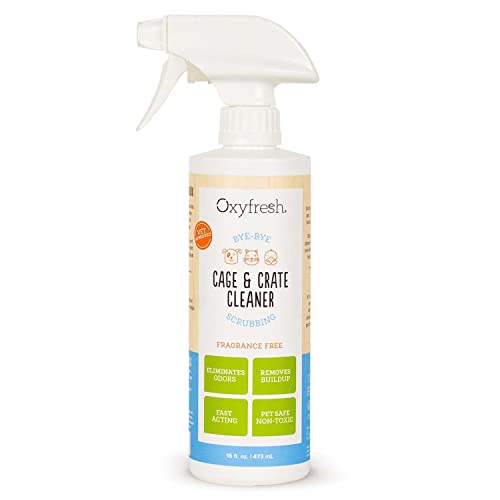
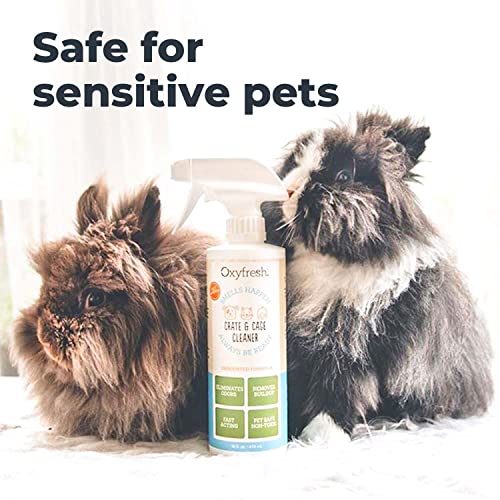
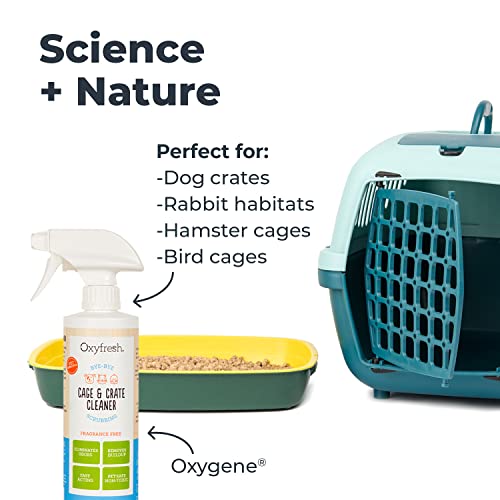
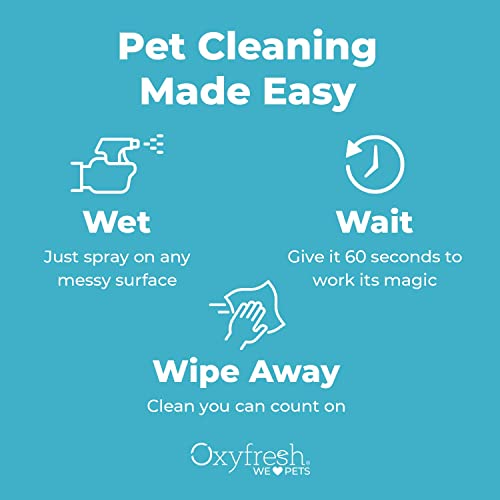
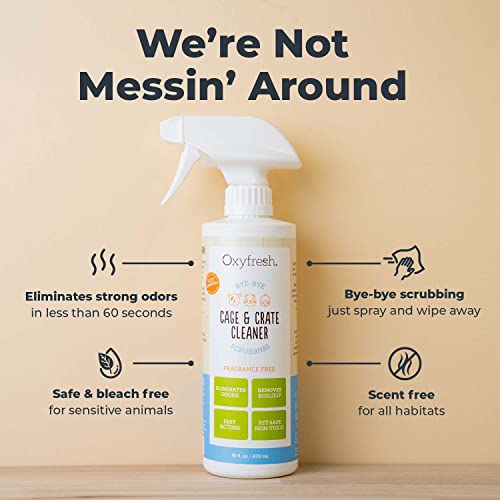
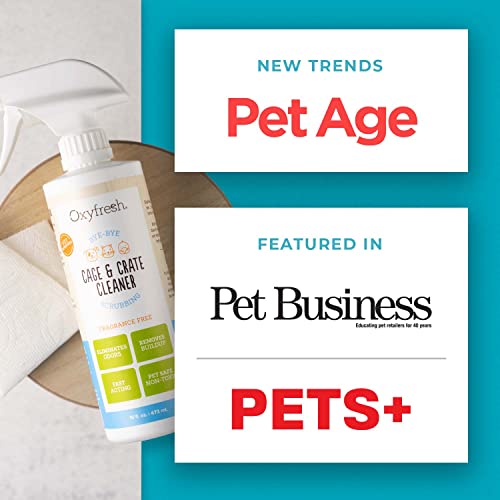

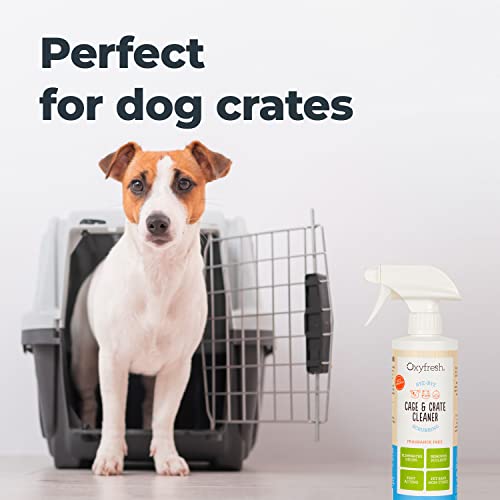
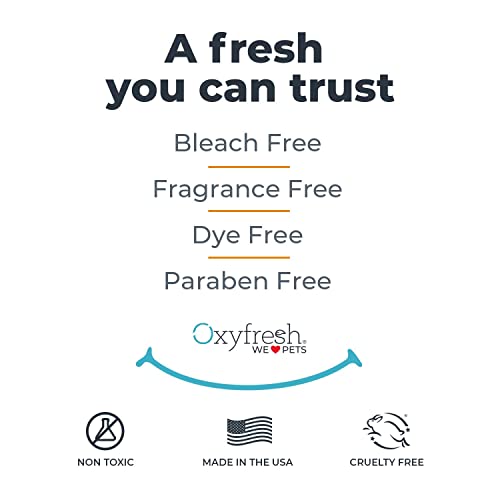
Oxyfresh Pet Odor & Stain Remover - Fast-Acting, Safe Formula for Small Animals, 16oz


Cocamidopropyl Betaine
High RiskCocamidopropyl betaine is a synthetic surfactant derived from coconut oil, commonly used in personal care products for its mild cleansing and foaming properties. It functions as a surfactant, emulsifier, and thickening agent, contributing to the texture and performance of formulations.
Sustai Insights
Cocamidopropyl betaine offers functional benefits as a gentle surfactant, enhancing product foaming and texture. However, it may pose low to moderate allergenic risks and is subject to high use restrictions due to contamination concerns. Regulatory bodies have advised on its safe levels of usage, categorizing its risk level as high overall. Users should practice caution, particularly with sensitive populations, and consider alternatives like naturally derived surfactants for safer formulations.
Sodium Hydroxide
High RiskSodium hydroxide is a highly caustic and reactive inorganic compound commonly used as a pH adjuster in various products. It is effective in neutralizing acids and plays a role in the production of soaps and detergents.
Sustai Insights
Sodium hydroxide serves essential functions, particularly in adjusting pH levels, but poses significant health risks, including skin and eye irritation. It is subject to high usage restrictions due to its corrosive nature. Environmental concerns include its potential to pollute water sources and contribute to ecosystem damage. Regulatory bodies have imposed strict guidelines on its use, indicating a high-risk profile for products containing this ingredient. Safe handling practices are crucial, and alternatives include milder pH adjusters, emphasizing the need for caution in its application.
Sodium Lauryl Sulfate
Low RiskSodium lauryl sulfate is the sodium salt of lauryl sulfuric acid, commonly used as a surfactant in various personal care and cleaning products. It functions primarily to create lather and reduce surface tension, facilitating the distribution of other ingredients.
Sustai Insights
Sodium lauryl sulfate effectively serves as a surfactant, enhancing product performance in cleansing formulations. It is generally considered to have low health risks, with minimal concerns regarding carcinogenicity, allergy, or reproductive toxicity. Environmental impact is also low, as it is not classified as a bioaccumulative pollutant. Regulatory bodies, including the FDA, impose no significant restrictions on its use. Safe usage practices should still be observed to minimize skin irritation. Overall, sodium lauryl sulfate is assessed as low risk, with alternatives like sodium coco sulfate available for those seeking more sustainable options.
Sorbitol
Low RiskSorbitol (glucitol) is a type of sugar alcohol used primarily as a sweetener and humectant in various food and cosmetic products. It is known for its moisture-retaining properties and is often found in sugar-free foods and personal care formulations.
Sustai Insights
Sorbitol serves effectively as a sweetener and humectant while being considered biodegradable and sustainably sourced. Health risks are low, with no significant concerns regarding carcinogenicity, allergies, or reproductive toxicity. Environmental assessments indicate minimal pollutant potential and low bioaccumulation. Regulatory bodies, including the FDA, have approved its use, but it is subject to specific guidelines. Overall, sorbitol presents a low risk profile, making it a suitable ingredient in food and cosmetic applications.
Sodium Phosphate
Low RiskSodium phosphate is an inorganic salt utilized primarily as an emulsifier, thickening agent, and pH regulator in various products, including food and personal care items. It plays a crucial role in stabilizing formulations and enhancing texture.
Sustai Insights
Sodium phosphate functions effectively as an emulsifier and pH regulator, contributing to product stability. It is generally recognized as safe by regulatory agencies, with low concerns related to carcinogenicity, allergies, and reproductive toxicity. However, it may cause irritation upon skin or eye contact. Environmentally, it poses minimal risks, with low pollutant potential. Overall, sodium phosphate is assessed as low risk, making it a reliable ingredient in formulations. For those seeking alternatives, consider using plant-based emulsifiers, which may offer similar functional benefits.
Water
Low RiskWater is a clear, colorless liquid essential for various biological processes. It serves as a solvent in formulations, facilitating the dissolution of other ingredients and enhancing product texture and application. Additionally, water plays a crucial role in hydration and is a key component in many cosmetic and personal care products.
Sustai Insights
Water is an effective solvent and hydrator, contributing to the texture and efficacy of formulations. It is biodegradable and generally regarded as safe, with low concerns regarding carcinogenicity, allergies, and reproductive toxicity. However, excessive water usage can lead to environmental concerns, particularly regarding resource depletion. Regulatory bodies do not impose restrictions on water use in cosmetics. Overall, the risks associated with water are low, making it a safe and essential ingredient.
Caprylyl Glycol
Low RiskCaprylyl glycol (1,2-octanediol) is a multifunctional cosmetic ingredient primarily used as a skin-conditioning agent and preservative. It is derived from caprylic acid, a fatty acid found in coconut oil, and is commonly included in personal care products for its moisturizing properties.
Sustai Insights
Caprylyl glycol offers functional benefits such as acting as an effective humectant and preservative, enhancing skin hydration and product stability. It is considered to have low health risks, with no significant concerns regarding carcinogenicity, allergies, or reproductive toxicity. Environmentally, it poses minimal risks, being non-bioaccumulative and not linked to pollution. Regulatory assessments affirm its safety, with no major advisories against its use. Overall, the ingredient is assessed to have a low risk, making it a suitable choice in cosmetic formulations.
Isopropyl Myristate
Low RiskIsopropyl myristate is composed of isopropyl alcohol and myristic acid. It functions primarily as an emollient, solvent, and skin penetration enhancer in cosmetic formulations. This ingredient is commonly found in creams, lotions, and other topical products to improve texture and absorption.
Sustai Insights
Isopropyl myristate offers functional benefits as an emollient and solvent, enhancing the texture and absorption of products. It is generally recognized as having low health risks, with no significant concerns regarding carcinogenicity, allergies, or reproductive toxicity. Environmentally, it poses minimal risks, not being classified as a pollutant or bioaccumulative. Regulatory bodies have not imposed significant restrictions, supporting its safe use in cosmetics. Overall, the risk level associated with isopropyl myristate is low, making it a generally safe ingredient in cosmetic formulations.
Sodium Lauryl Sulfate
Low RiskSodium lauryl sulfate is the sodium salt of lauryl sulfuric acid, commonly used as a surfactant in various personal care and cleaning products. It functions primarily to create lather and reduce surface tension, facilitating the distribution of other ingredients.
Sustai Insights
Sodium lauryl sulfate effectively serves as a surfactant, enhancing product performance in cleansing formulations. It is generally considered to have low health risks, with minimal concerns regarding carcinogenicity, allergy, or reproductive toxicity. Environmental impact is also low, as it is not classified as a bioaccumulative pollutant. Regulatory bodies, including the FDA, impose no significant restrictions on its use. Safe usage practices should still be observed to minimize skin irritation. Overall, sodium lauryl sulfate is assessed as low risk, with alternatives like sodium coco sulfate available for those seeking more sustainable options.
Cocamidopropyl Betaine
High RiskCocamidopropyl betaine is a synthetic surfactant derived from coconut oil, commonly used in personal care products for its mild cleansing and foaming properties. It functions as a surfactant, emulsifier, and thickening agent, contributing to the texture and performance of formulations.
Sustai Insights
Cocamidopropyl betaine offers functional benefits as a gentle surfactant, enhancing product foaming and texture. However, it may pose low to moderate allergenic risks and is subject to high use restrictions due to contamination concerns. Regulatory bodies have advised on its safe levels of usage, categorizing its risk level as high overall. Users should practice caution, particularly with sensitive populations, and consider alternatives like naturally derived surfactants for safer formulations.
Sorbitol
Low RiskSorbitol (glucitol) is a type of sugar alcohol used primarily as a sweetener and humectant in various food and cosmetic products. It is known for its moisture-retaining properties and is often found in sugar-free foods and personal care formulations.
Sustai Insights
Sorbitol serves effectively as a sweetener and humectant while being considered biodegradable and sustainably sourced. Health risks are low, with no significant concerns regarding carcinogenicity, allergies, or reproductive toxicity. Environmental assessments indicate minimal pollutant potential and low bioaccumulation. Regulatory bodies, including the FDA, have approved its use, but it is subject to specific guidelines. Overall, sorbitol presents a low risk profile, making it a suitable ingredient in food and cosmetic applications.
Sodium Hydroxide
High RiskSodium hydroxide is a highly caustic and reactive inorganic compound commonly used as a pH adjuster in various products. It is effective in neutralizing acids and plays a role in the production of soaps and detergents.
Sustai Insights
Sodium hydroxide serves essential functions, particularly in adjusting pH levels, but poses significant health risks, including skin and eye irritation. It is subject to high usage restrictions due to its corrosive nature. Environmental concerns include its potential to pollute water sources and contribute to ecosystem damage. Regulatory bodies have imposed strict guidelines on its use, indicating a high-risk profile for products containing this ingredient. Safe handling practices are crucial, and alternatives include milder pH adjusters, emphasizing the need for caution in its application.
Sodium Phosphate
Low RiskSodium phosphate is an inorganic salt utilized primarily as an emulsifier, thickening agent, and pH regulator in various products, including food and personal care items. It plays a crucial role in stabilizing formulations and enhancing texture.
Sustai Insights
Sodium phosphate functions effectively as an emulsifier and pH regulator, contributing to product stability. It is generally recognized as safe by regulatory agencies, with low concerns related to carcinogenicity, allergies, and reproductive toxicity. However, it may cause irritation upon skin or eye contact. Environmentally, it poses minimal risks, with low pollutant potential. Overall, sodium phosphate is assessed as low risk, making it a reliable ingredient in formulations. For those seeking alternatives, consider using plant-based emulsifiers, which may offer similar functional benefits.
Water
Low RiskWater is a clear, colorless liquid essential for various biological processes. It serves as a solvent in formulations, facilitating the dissolution of other ingredients and enhancing product texture and application. Additionally, water plays a crucial role in hydration and is a key component in many cosmetic and personal care products.
Sustai Insights
Water is an effective solvent and hydrator, contributing to the texture and efficacy of formulations. It is biodegradable and generally regarded as safe, with low concerns regarding carcinogenicity, allergies, and reproductive toxicity. However, excessive water usage can lead to environmental concerns, particularly regarding resource depletion. Regulatory bodies do not impose restrictions on water use in cosmetics. Overall, the risks associated with water are low, making it a safe and essential ingredient.
Caprylyl Glycol
Low RiskCaprylyl glycol (1,2-octanediol) is a multifunctional cosmetic ingredient primarily used as a skin-conditioning agent and preservative. It is derived from caprylic acid, a fatty acid found in coconut oil, and is commonly included in personal care products for its moisturizing properties.
Sustai Insights
Caprylyl glycol offers functional benefits such as acting as an effective humectant and preservative, enhancing skin hydration and product stability. It is considered to have low health risks, with no significant concerns regarding carcinogenicity, allergies, or reproductive toxicity. Environmentally, it poses minimal risks, being non-bioaccumulative and not linked to pollution. Regulatory assessments affirm its safety, with no major advisories against its use. Overall, the ingredient is assessed to have a low risk, making it a suitable choice in cosmetic formulations.
Isopropyl Myristate
Low RiskIsopropyl myristate is composed of isopropyl alcohol and myristic acid. It functions primarily as an emollient, solvent, and skin penetration enhancer in cosmetic formulations. This ingredient is commonly found in creams, lotions, and other topical products to improve texture and absorption.
Sustai Insights
Isopropyl myristate offers functional benefits as an emollient and solvent, enhancing the texture and absorption of products. It is generally recognized as having low health risks, with no significant concerns regarding carcinogenicity, allergies, or reproductive toxicity. Environmentally, it poses minimal risks, not being classified as a pollutant or bioaccumulative. Regulatory bodies have not imposed significant restrictions, supporting its safe use in cosmetics. Overall, the risk level associated with isopropyl myristate is low, making it a generally safe ingredient in cosmetic formulations.
Discover the Oxyfresh Premium Crate & Cage Cleaner, the ultimate solution for pet owners seeking a quick and effective way to eliminate odors and stains. This non-toxic cleaner is designed for small animals and birds, ensuring a safe environment for your furry friends.
- Effortless Cleaning: Simply spray and wipe away messes without rinsing, thanks to a formula free from harsh chemicals and dyes.
- Rapid Odor Elimination: Instantly tackles urine, poop, and other stubborn odors, leaving cages and crates fresh and clean.
- Safe for Sensitive Pets: Specially formulated for small animals like bunnies and hamsters, ensuring their health and safety.
- Versatile Use: Ideal for various sizes of crates and kennels, making it a must-have for all pet owners.
- Trustworthy Ingredients: Bleach-free, alcohol-free, and cruelty-free, providing peace of mind with every use.
Make pet hygiene simple and effective with Oxyfresh, a brand committed to ethical practices and community impact.
Subscribe & Save with Sustai
- Best Price Guarantee: Always enjoy the lowest prices on sustainable home essentials.
- No Surprises: We’ll notify you before shipping. No hidden fees, ever.
- You’re in Charge: Change, pause, or cancel your subscription anytime with ease.
- Eco-Friendly Deliveries: Our grouped shipments mean less packaging and lower emissions.
Join us on a sustainable journey. Special offers for a limited time! Prices and promotions may change.
Recommended Products
Discover the Oxyfresh Premium Crate & Cage Cleaner, the ultimate solution for pet owners seeking a quick and effective way to eliminate odors and stains. This non-toxic cleaner is designed for small animals and birds, ensuring a safe environment for your furry friends.
- Effortless Cleaning: Simply spray and wipe away messes without rinsing, thanks to a formula free from harsh chemicals and dyes.
- Rapid Odor Elimination: Instantly tackles urine, poop, and other stubborn odors, leaving cages and crates fresh and clean.
- Safe for Sensitive Pets: Specially formulated for small animals like bunnies and hamsters, ensuring their health and safety.
- Versatile Use: Ideal for various sizes of crates and kennels, making it a must-have for all pet owners.
- Trustworthy Ingredients: Bleach-free, alcohol-free, and cruelty-free, providing peace of mind with every use.
Make pet hygiene simple and effective with Oxyfresh, a brand committed to ethical practices and community impact.

You can have at most 2 Sustainable Steals products in your cart
Customer Reviews
Customers’ View
Customers appreciate the effectiveness and safety of the Pet Odor Eliminator, noting its ability to swiftly eliminate stubborn odors and stains. Many users commend the product's gentle formula, highlighting that it is non-toxic and safe for pets, which aligns with their health-conscious values. The pleasant, light scent is frequently mentioned, with customers expressing satisfaction that it doesn't overpower their living spaces. They also value the ease of use, with several comments reflecting how the product significantly reduces cleaning time. Overall, consumers find this cleaner to be a reliable choice that supports their eco-friendly lifestyle while effectively maintaining a clean environment for their pets.
AI-generated from the text of customer reviewsThis product is rated 5.0 of 5.0 stars.
It has received 3 reviews.





